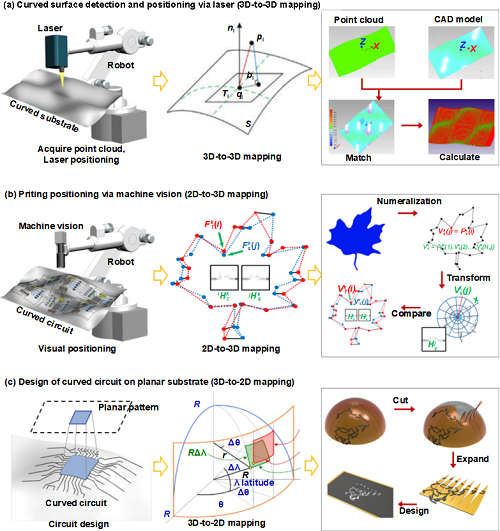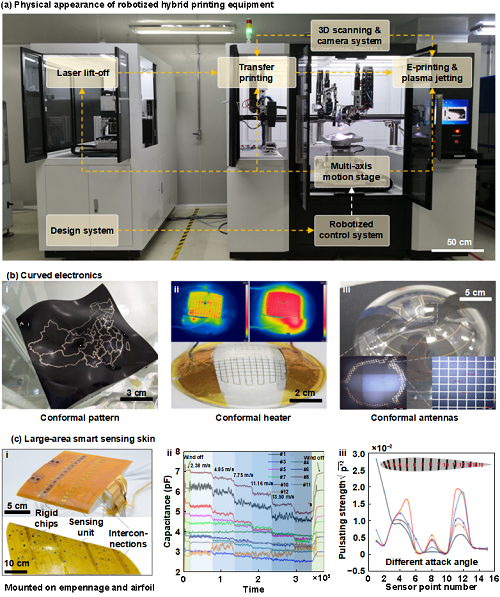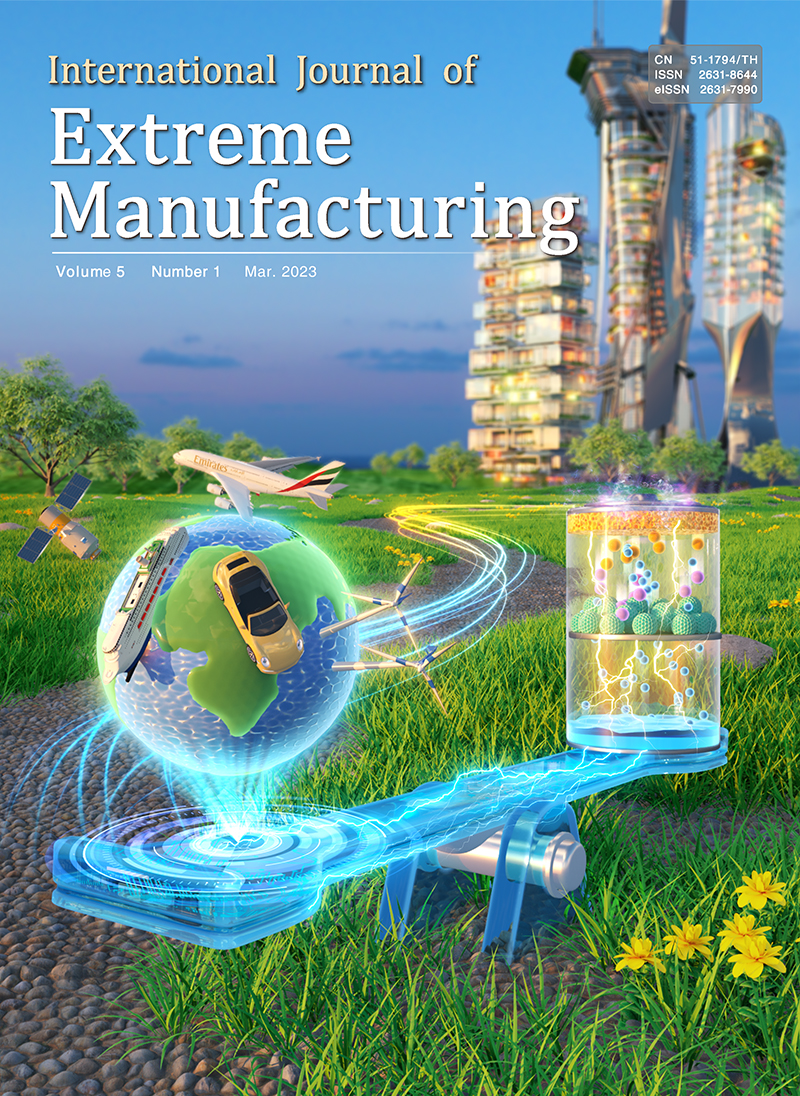PAPER ● OPEN ACCESSRead More
1. Introduction
Large-scale 3D curved electronic devices that conformally and directly integrated on complex surface, have become the development trend of the microelectronics industry and applications, because of their unique ability to coexist with the high-performance electronic characteristics of traditional microelectronic devices, such as smart skin for aircrafts, electronic skin for robots and smart glass for cars. Although current stretchable electronics can be well conformal with common curved surface, their size is limited by the wafer size and the application of their substrate materials in extreme environments. Micro-contact printing can also be conformal with curved surface through soft stamp to realize functional material transfer, but the manufacturing of electronic devices on high curvature surfaces still needs to be carried out in depth. Robotic inkjet printing takes the advantages of good flexibility and additive manufacturing characteristics, but it cannot realize the manufacture of precise electronic devices on complex curved surface. Here, Professor YongAn Huang, Dr. Hao Wu and others from the State Key Laboratory of Digital Manufacturing Equipment and Technology of Huazhong University of Science and Technology published "Programmable robotized “transfer-and-jet” printing for large-area, 3D curved electronics on complex surface" in the "International Journal of Extreme Manufacturing" (IJEM). A novel robotized "transfer and jet" printing strategy has been proposed to realize multi-process combinations through programmable methods, which integrates a series of core technologies and methods such as "2D-3D" mapping, conformal printing, laser lift-off, curved surface transfer printing, etc. It can satisfy different material, shape, size, function, performance of electronic system integrations, break through the limitations of small-area, planar from electronic devices fabrication, and provide a powerful new and effective solution for assembling curved electronics, especially for R&D production that integrates design, testing, and manufacturing, and can significantly shorten the production cycle.
Keywords:conformal printing, curved electronics, complex surfaces, robotic fabrication
2. Background
Figure 1a shows a typical 3D curved electronic system, such as a large-area smart sensing aircraft skin, which integrates a set of electronic and functional units on the curved surface, including a microprocessor chip, a conformal antenna, a flexible sensor, and interconnection/circuits, and functional microstructures. Different from traditional microelectronics, its substrate geometry becomes complicated, such as non-expandable or free-form surfaces, with a much larger area (> 1 m2). However, the shapes and sizes of massive chips, flexible devices, conformal antennas, interconnections/circuits are different, ranging from 100μm to 1cm, thickness from 50μm to 1mm and feature width even less than 1 μm.
Figure 1b illustrates the basic process and key technologies of robotized “transfer and jet” hybrid printing. It can conformally manufacture the curved electronic devices on complex 3D surfaces, which are designed through computer. Using the flexibility of the robot system, it can arrange and combine various processes (such as inkjet printing, transfer printing, plasma treating, sintering, etc.) according to the structural characteristics of different functional electronic systems, to meet the rapid realization of personalized and customizable systems.

Figure 1. (a)Schematic diagram of a large-area smart skin for an aircraft (b)The robotized 'transfer-and-jet' printing as a manufacturing strategy
3. Recent Advances
The biggest difference and challenge between complex-curved electronics and planar electronic are the complex shape of the substrates, which requires to solve the curved-to-curved surface mapping involving the matching between actual substrate and computer model, planar-to-curved surface mapping in machine vision positioning, and curved-to-planar surface mapping in planar designing of 3D circuits, etc. (as shown in Figure 2). The precision of surface positioning is guaranteed by a laser scanner and machine vision, then use the control system to realize data analysis, operation and process planning. Finally, robotic hybrid printing uses the permutation and combination of inkjet printing, transfer printing and plasma processing to manufacture electronic systems in a point-by-point, non-contact and programmable manner. These processes should be able to adapt to complex and changeable requirements to use limited tools to achieve different types of manufacturing. For example, inkjet printing should be able to directly manufacture dots, lines and films of various materials. Transfer printing should be able to peel, pick up and transfer small rigid chips and large flexible electronic devices. The plasma treatment should be able to etch, modify and weld various thin films. And the electrohydrodynamic lithography process can break through the limitations caused by planar masks, and enlarge the process to arbitrary complex surface.

Figure 2. Surface mapping technologies in robotized hybrid manufacturing: (a) 3D-to-3D mapping via laser displacement sensor. (b) 2D-to-3D mapping for precise positioning via machine vision. and (c) 3D-to-2D mapping for assembly of curved surface.
Figure 3a illustrates an equipment of robotized “transfer-and-jet” printing technique, which integrates surface measurement and reconstruction, conformal printing, laser lift-off, transfer printing, machine vision, 5/6-axis linkage and other modules. It can manufacture/integrate diverse electronic devices on 3D curved surface, such as rigid chips, flexible sensors and conformal circuits, etc. For example, as shown in Figure 3b, a conductive map of China was obtained by additive manufacturing on a complex curved surface, a spherical heater and a transparent conformal antenna were fabricated by electrohydrodynamic lithography, and a flexible smart skin was assembled on a winged model. The results show that robotized hybrid manufacturing is a powerful method for 3D curved electronics.

Figure 3. Robotized hybrid printing equipment and its applications. (a) Self-developed, robotized hybrid printing equipment. (b) Applications of curved electronics: curved circuits on complex surface, a spherical heater and a transparent conformal antenna. (c) The large-area smart sensing skin (iFlexSense) mounted on standard wings
4.Perspectives
The robotized hybrid printing equipment is a manufacturing system with robots as the motion carriers, integrating process system, measurement system, path planning system, etc. This system autonomically controls its components via measurement data and process knowledge. This endows the robotized printing system with high flexibility and compliance, and it is suitable for fabricating large area micro-nano structure and functional devices on highly complex surfaces. Therefore, it brings about technological revolution, from “small-area” to “large-area,” from “planar” to “curved,” from “rigid” to “flexible,” and from merely additive printing or subtractive lithography process to hybrid processes. Although robotized hybrid printing shows great potential in large-area, multifunctional, curved electronic systems with distributed sensors, circuit, and actuators, there are still many challenges in the fabrication process, such as manufacturing multi-scale or multi-layered structures, increased efficiency, and integrated functionality.
5. About the Authors

YongAn Huang, professor of the School of Mechanical Science and Engineering, Huazhong University of Science and Technology, winner of the National Science Fund for Outstanding Young Scholars, vice director of the State Key Laboratory of Digital Manufacturing Equipment and Technology. He is committed to the research of flexible electronic devices and manufacturing, including electrohydrodynamic printing, laser lift-off, conformal transfer printing, mass transfer and other manufacturing technologies and equipment, as well as innovative applications such as aircraft smart skin, bio-integrated electronics, robot electronic skin and flexible displays.










